MIMO OFDM MATLAB 仿真程序一
OFDM.m: OFDM Simulator (outer function) clear all;
A = [1 1/exp(1) 1/exp(2)]; % power delay profile N = 64; % number of
symbols in a single OFDM symbol GI = 16; % guard interval
Mt = 1; % number of Tx antennas
Mr = 1; % number of Rx antennas
sig2 = 1e-3; % noise variance
M = 8; % max constellation bit number
Mgap = 10.^(1:(1.7/10):2.7); % gap
Btot = 100*Mt; % total # bits per OFDM symbol TransmitIter = 50; % #
iterations of symbol transmissions for each channel instance
ChannelIter = 100; % # iterations of independent identically
distributed channel instances
GapIter = length(Mgap);
load ENC2.mat
load ENC4.mat
load ENC16.mat
load ENC64.mat
load ENC256.mat
TotEbNo = [];
Errors =[];
EbNo = [];
for lGap = 1:GapIter
�
lGap
gap = Mgap(lGap);
totalErrors = 0;
for lChan = 1:ChannelIter
% create channel
[H h_f]=create_channel(Mt, Mr, A, N+GI);
% decompose each subchannel in the frequency domain [U S V] =
svd_decompose_channel(Mt, Mr, h_f, N);
% bitloading
[bits_alloc,energy_alloc] = BitLoad(S,Btot,Mt*N,gap,sig2,M);
%energy_alloc=energy_alloc/(mean(energy_alloc));
%energy_alloc=ones(1,128);
for lTrans = 1:TransmitIter
% bits to transmit
x = (randn(1,Btot)>0);
% modulate
x_mod = modulate(x,bits_alloc,energy_alloc, s2,s4,s16,s64,s256);
% precode modulated signal
x_pre = precode(Mt, x_mod, V, N);
% ifft, with cyclic prefix for each antenna
ofdm_symbol =[];
for i=1:Mt
ofdm_symbol = [ofdm_symbol; ifft_cp_tx_blk(x_pre(i:Mt:Mt*(N-
1)+i),N,GI)]; end
�
ofdm_symbol2 = reshape(ofdm_symbol,Mt*(N+GI),1);
% channel
y = transpose(channel(sig2, Mt, Mr, ofdm_symbol2, H, N+GI));
% fft
rec_symbol =[];
for i=1:Mt
rec_symbol = [rec_symbol; fft_cp_rx_blk(y(i:Mt:Mt*(N+GI-1)+i),N,GI)];
end
rec_symbol2 = reshape(rec_symbol,1,Mt*N);
% shape received signal
shaped_vals = shape(rec_symbol2, Mr, U, N);
% demodulate
y_demod = demodulate(shaped_vals, bits_alloc, energy_alloc, S,
s2,s4,s16,s64,s256, c2,c4,c16,c64,c256);
% comparison
totalErrors = totalErrors + sum(xor(y_demod,x));
end
EbNo = [EbNo sum(energy_alloc)/Btot/sig2];
end
Errors = [Errors totalErrors/Btot/ChannelIter/TransmitIter] TotEbNo
= [TotEbNo mean(EbNo)]
EbNo = [];
end
semilogx(TotEbNo, Errors);
�
xlabel('Eb/No');
ylabel('BER');
title('SISO link, adaptive rate and power')
save SISO_adaptive2.mat Errors EbNo
create_channel.m: Generates a Rayleigh fading frequency-selective
channel,
parametrized by the antenna configuration, the OFDM configuration,
and the
power-delay profile.
function [H, H_f]=create_channel(Mt, Mr, A, N); % function [H,
H_f]=create_channel(Mt, Mr, A, N); %
% A - vector containing the power-delay profile (real values)
% Mt - number of Tx antennas
% Mr - number of Rx antennas
% N - number of vector symbols to be sent in a single OFDM symbol Tx
% ie: N MIMO transmissions in one OFDM symbol
% This is for Rayleigh frequency-selective fading, which assumes
complex
% Gaussian matrix elements with in-phase and quadrature components
independent.
% Assume iid matrix channel elements, and further, independent
channel taps
% define the channel taps
�
H_int = 1/sqrt(2)*(randn(Mr*length(A),Mt) +
j*randn(Mr*length(A),Mt));
H_int2=[];
for i = 1:length(A)
H_int2 = [H_int2;sqrt(A(i))*H_int((i-1)*Mr+1:i*Mr,:)]; end
%h_f = fft(H_int2',64);
%%H = H_int2';
H_int2 = [H_int2;zeros((N-length(A))*Mr,Mt)];
H_f = zeros(Mr,Mt*(N-16));
for i = 1:Mt
for j = 1:Mr
h_f = fft(H_int2(j:Mr:(N-16-1)*Mr+j,i));
for k = 1:(N-16)
H_f(j,i+(k-1)*Mt) = h_f(k);
end
end
end
H=[H_int2];
for i = 1:N-1
H=[H,[zeros(Mr*i,Mt);H_int2(1:(N-i)*Mr,:)]]; end
svd_decompose_channel.m: Since full channel knowledge is assumed,
transmission
is across parallel singular value modes. This function decomposes
the channel into
�
these modes.
function [U, S, V] = svd_decompose_channel(Mt, Mr, h_f, N); % [U S V]
= svd_decompose_channel(Mt, Mr, h_f, N); %
% Function decomposes the channel at each subcarrier into its SVD
components
%
% Mt - # Tx antennas
% Mr - # Rx antennas
% h_f - MIMO impulse response - Mr rows, Mt*L columns, where L is
the number
of
% channel taps
% N - # subcarriers
U = [];
S = [];
V = [];
for i = 1:N
[Utmp Stmp Vtmp] = svd(h_f(:,(i-1)*Mt+1:i*Mt));
U=[U Utmp];
V=[V Vtmp];
S=[S Stmp];
end
S = sum(S,1);
�
BitLoad.m: Apply the bit-loading algorithm to achieve the desired
bit and energy
allocation for the current channel instance.
function [bits_alloc,energy_alloc] =
BitLoad(subchan_gains,total_bits,num_subc,gap,noise,M)
% Bit Loading Algorithm
% ---------------------
%
% Inputs :
% subchan_gains : SubCarrier Gains
% total_bits : Total Number of bits
% num_subc : Number of Subcarriers
% gap : Gap of the system
% noise : Noise Power
% M : Max Constellation Size
% Outputs:
% bits_alloc : Bits allocation for each subchannel % power_alloc :
Total Power allocation % -----------------------------------------------
----------------
% Compute SNR's for each channel
SNR = ComputeSNR(subchan_gains,noise,gap);
% This function just initializes the system with a particular bit %
allocation and energy allocation using Chow's Algorithm. This is %
further efficientize using Campello's Algorithm
�
[bits_alloc, energy_alloc] = chow_algo(SNR,num_subc,M);
% Form the Energy Increment Table based on the present channel %
gains for all the subchannels in order to be used by Campello %
Algorithm
energytable = EnergyTableInit(SNR,M);
% Efficientize the algorithm using the Campello's algorithm
[bits_alloc,energy_alloc] =
campello_algo(bits_alloc,energy_alloc,energytable,total_bits,num_sub
c,M
);
ComputeSNR.m: Given the subcarrier gains, this simple function
generates the SNR
values of each channel (each singular value on each tone is a
separate channel).
function SNR = ComputeSNR(subcar_gains,noise,gap)
SNR = abs((subcar_gains.^2)./(noise*gap));
chow_algo.m: Apply Chow's algorithm to generate a particular bit and
energy % Chow's Algorithm allocation. % ---------------- % This is based
on the paper by Chow et al titled
%
% A Practical Discrete Multitone Transceiver Loading Algorithm % for
Data Transmission over Spectrally Shaped Channels.IEEE Trans % on
Communications. Vol. 43, No 2/3/4, pp. 773-775, Feb/Mar/Apr 1995
function [bits_alloc, energy_alloc] = chow_algo(SNR,num_subc,M)
�
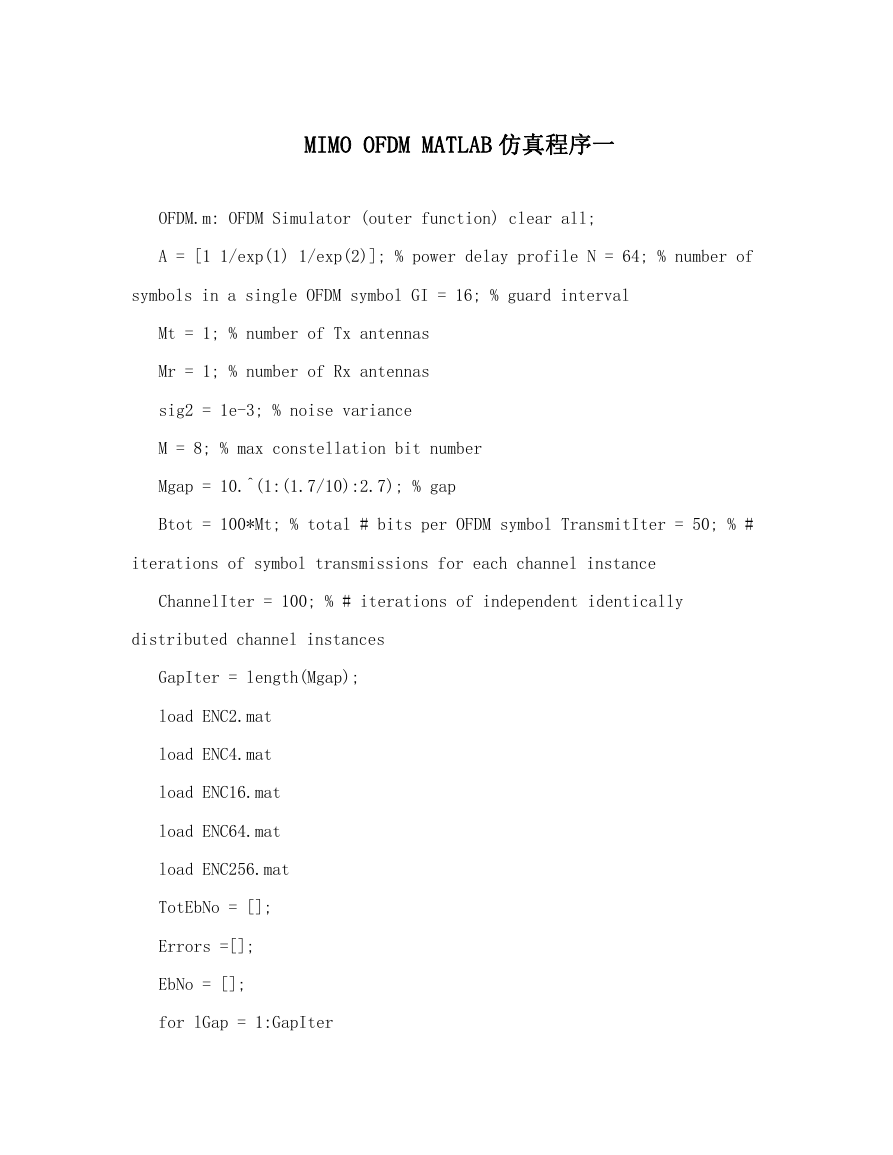

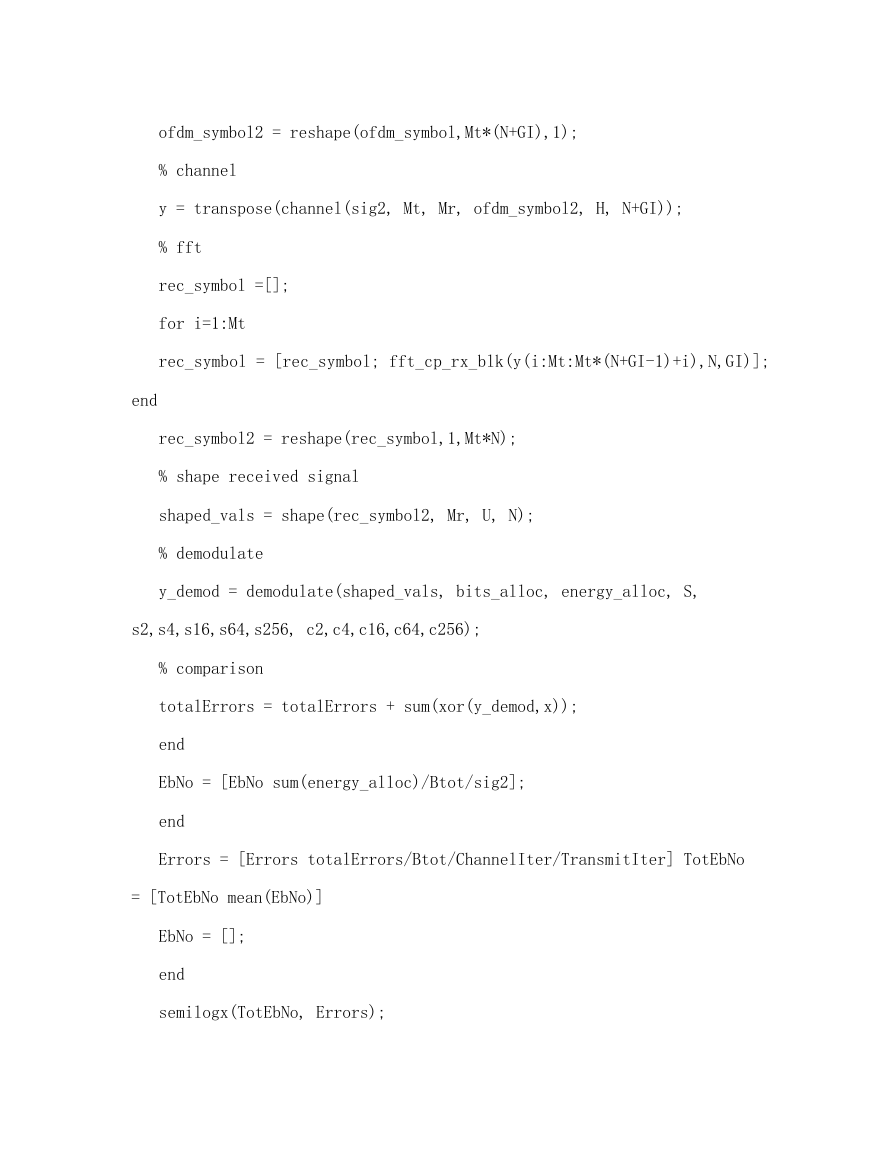

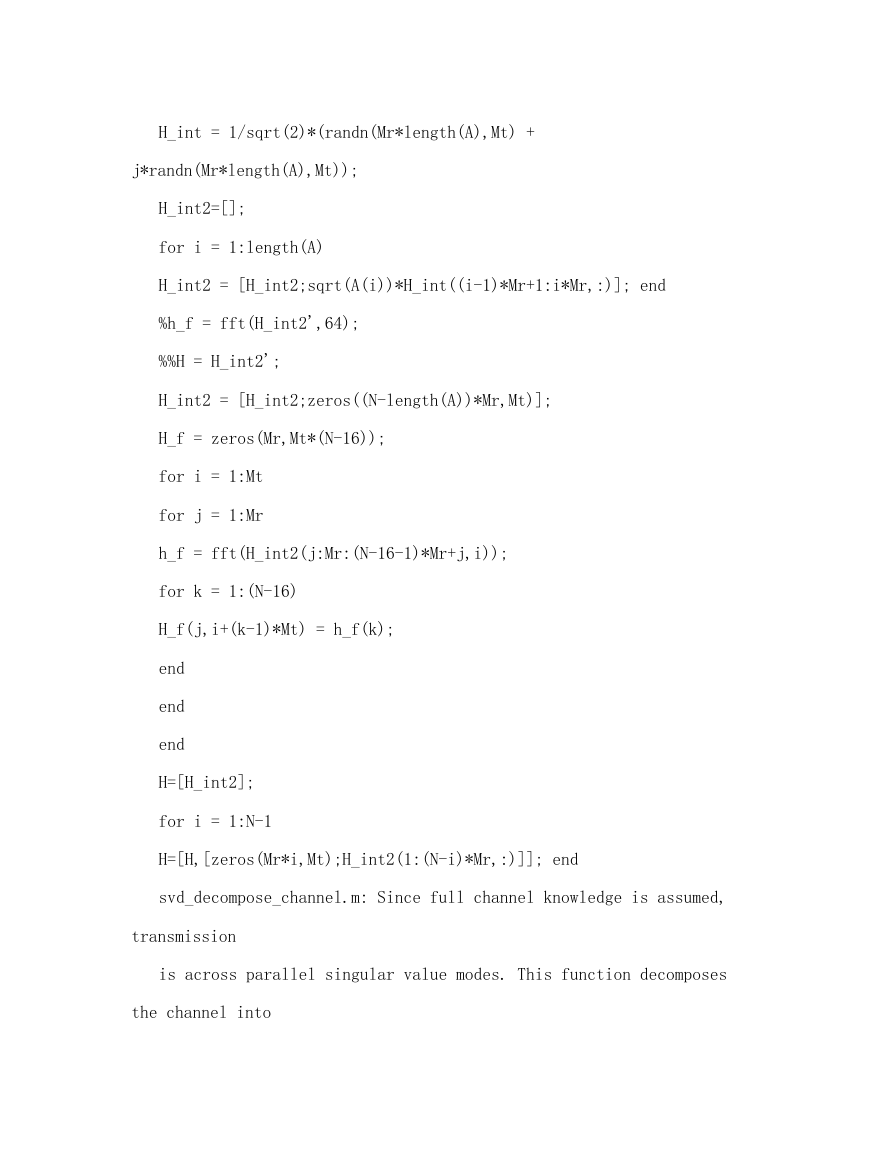
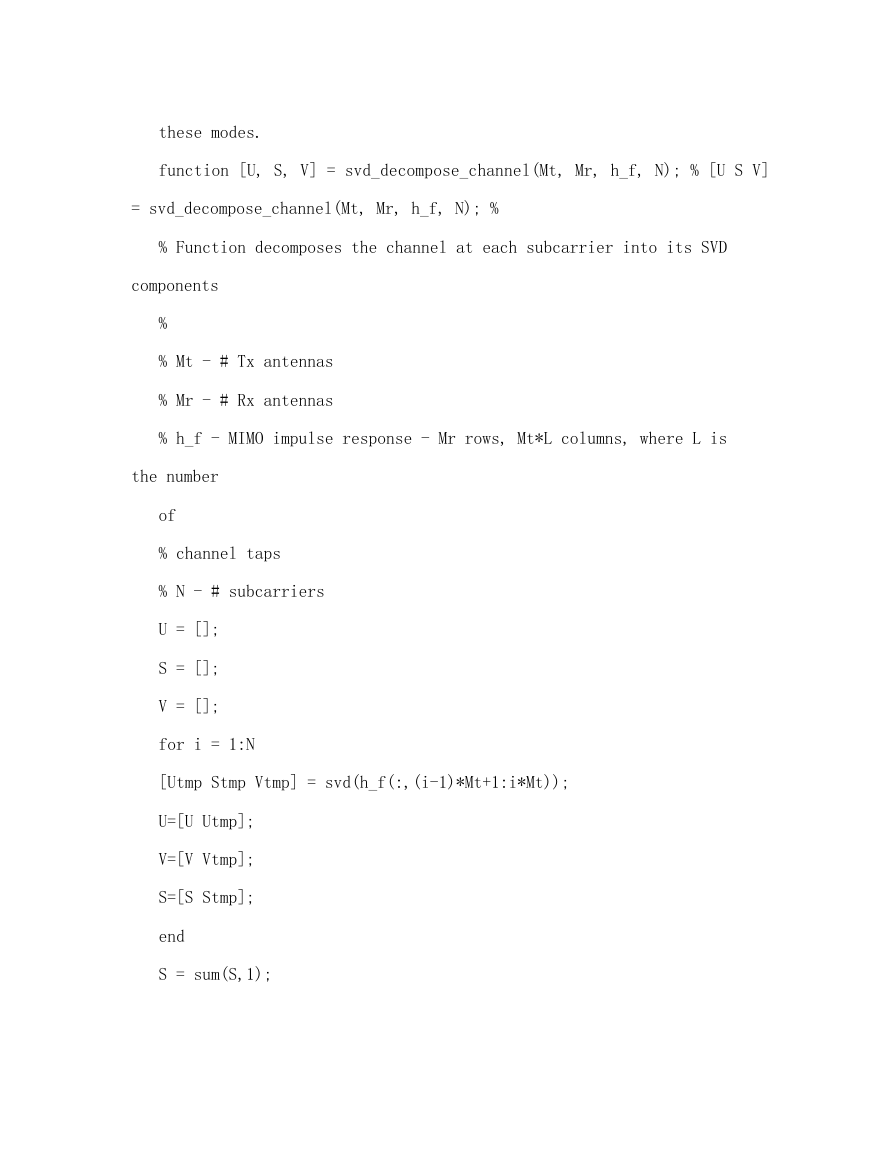

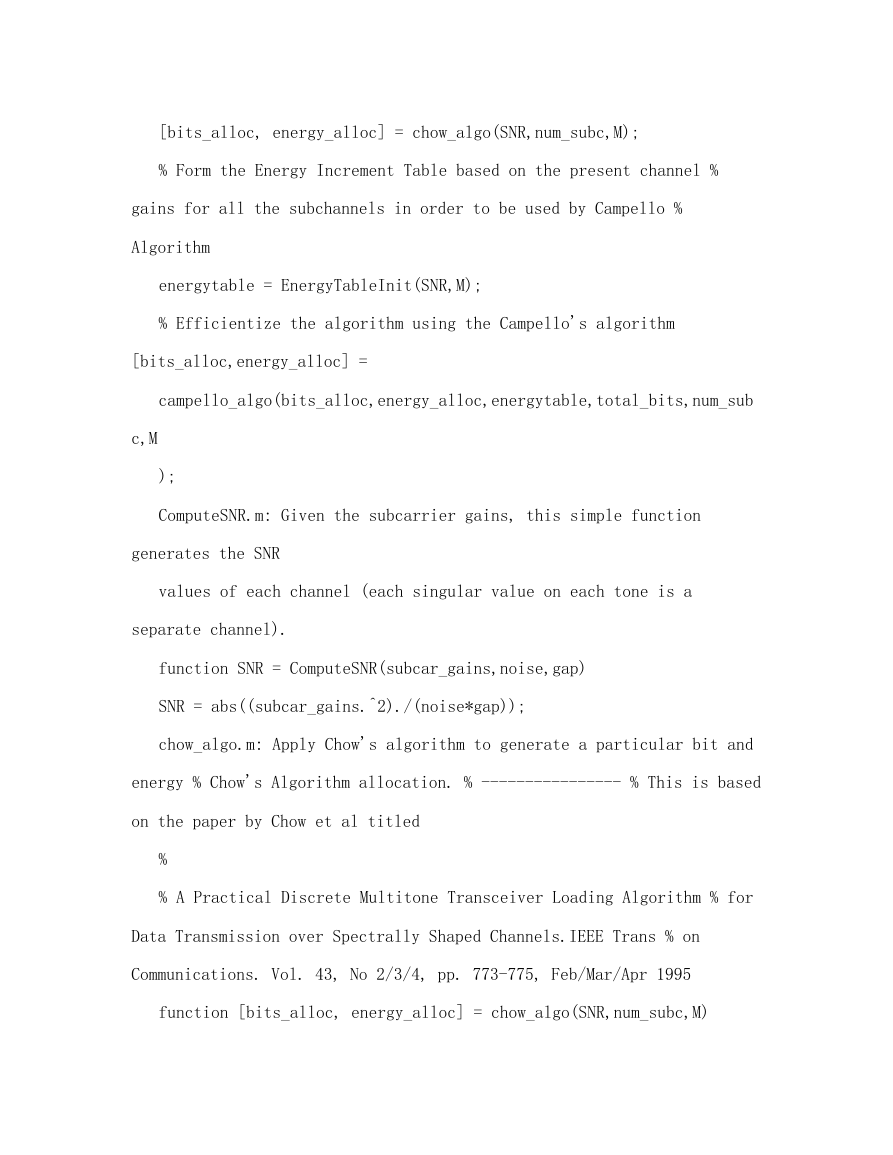








 2023年江西萍乡中考道德与法治真题及答案.doc
2023年江西萍乡中考道德与法治真题及答案.doc 2012年重庆南川中考生物真题及答案.doc
2012年重庆南川中考生物真题及答案.doc 2013年江西师范大学地理学综合及文艺理论基础考研真题.doc
2013年江西师范大学地理学综合及文艺理论基础考研真题.doc 2020年四川甘孜小升初语文真题及答案I卷.doc
2020年四川甘孜小升初语文真题及答案I卷.doc 2020年注册岩土工程师专业基础考试真题及答案.doc
2020年注册岩土工程师专业基础考试真题及答案.doc 2023-2024学年福建省厦门市九年级上学期数学月考试题及答案.doc
2023-2024学年福建省厦门市九年级上学期数学月考试题及答案.doc 2021-2022学年辽宁省沈阳市大东区九年级上学期语文期末试题及答案.doc
2021-2022学年辽宁省沈阳市大东区九年级上学期语文期末试题及答案.doc 2022-2023学年北京东城区初三第一学期物理期末试卷及答案.doc
2022-2023学年北京东城区初三第一学期物理期末试卷及答案.doc 2018上半年江西教师资格初中地理学科知识与教学能力真题及答案.doc
2018上半年江西教师资格初中地理学科知识与教学能力真题及答案.doc 2012年河北国家公务员申论考试真题及答案-省级.doc
2012年河北国家公务员申论考试真题及答案-省级.doc 2020-2021学年江苏省扬州市江都区邵樊片九年级上学期数学第一次质量检测试题及答案.doc
2020-2021学年江苏省扬州市江都区邵樊片九年级上学期数学第一次质量检测试题及答案.doc 2022下半年黑龙江教师资格证中学综合素质真题及答案.doc
2022下半年黑龙江教师资格证中学综合素质真题及答案.doc